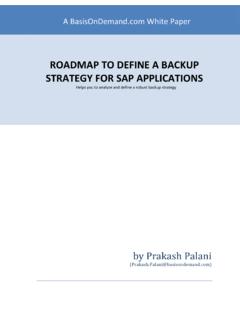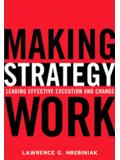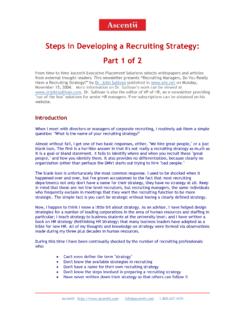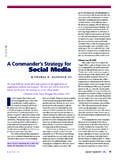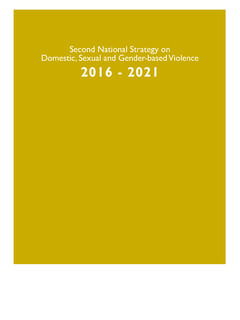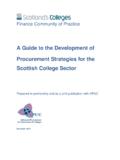Transcription of Aggregate Extraction in Ontario: A Strategy for the …
1 Aggregate Extraction in ontario : A Strategy for the Future March 2011. Aggregate Extraction in ontario : A Strategy for the Future by Matt Binstock and Maureen Carter-Whitney Canadian Institute for Environmental Law and Policy March 2011. Acknowledgements About CIELAP. The Canadian Institute for Environmental Law and Founded in 1970, the Canadian Institute for Policy (CIELAP) would like to thank all of the Environmental Law and Policy (CIELAP) is an various participants in this study who committed independent, not-for-profit professional research their time to being interviewed and to providing and educational institute committed to information; Gravel Watch ontario for providing environmental law and policy analysis and extensive input into the research process; and those reform.
2 CIELAP is incorporated under the laws who anonymously reviewed this paper. of the Province of ontario and registered with Revenue Canada as a charitable organization. We would also like to thank MEC and the George Our registration number is 11883 3417 RR0001. Cedric Metcalf Charitable Foundation for their financial assistance. CIELAP informs legislative, policy and regulatory outcomes for Sustainability at the national and provincial/territorial levels of government in Canada. About the Authors Matt Binstock is a Policy Researcher at CIELAP. Matt holds a Bachelors Degree in Environmental and Resource Studies from Trent Copyright 2011 Canadian Institute for University and a Masters Degree in Environmental Law and Policy.
3 Environmental Studies from York University. ISBN # 978-1-896588-70-4. Maureen Carter-Whitney ( , ), Research Director at CIELAP, is an environmental lawyer with a background in legal research and environmental public policy analysis, and a strong interest in sustainable land use planning and in public engagement in environmental decision-making. She also teaches environmental law and is the author of LexisNexis' looseleaf publication, Environmental Regulation in Canada. This publication can be downloaded from our website at Table of Contents Executive Summary .. i Summary of iii 1. Introduction and Background .. 1. 2. The 2009 State of the Aggregate Resource in ontario Study.
4 4. 3. Understanding the Controversy: Aggregate Extraction and Land Use Conflicts .. 6. 4. Environmental, Social and Human Health Impacts of Aggregate Extraction in ontario 9. Impacts on the Landscape .. 11. Loss of Agricultural Land .. 11. Impacts on Water Quantity .. 12. Impacts on Water Quality .. 14. Social and Human Health Impacts .. 14. Cumulative 15. Evaluating Environmental Impacts .. 16. 5. Legal and Policy Framework for Aggregates in 19. History of Aggregates Policy in 19. Provincial Policy Statement, 2005 .. 20. Aggregate Resources Act .. 21. Supporting Policy on Aggregates: Provincial Standards and the Policy and Procedures 21. Natural Heritage Reference 22.
5 Other Provincial Land Use Policies Governing Aggregate Management in ontario .. 22. 6. Current Issues in Aggregate Extraction in ontario .. 25. Balancing the need for Mineral Aggregate with other Land Use Interests in a High Growth Region .. 25. Supply and Demand for Aggregates .. 30. Underutilization of Recycled 32. Site Plan Amendments .. 38. Rehabilitation .. 41. Compliance Monitoring .. 47. Pricing and Accounting for the Cost of Aggregates .. 49. 7. Long-Term Considerations for Aggregates Management in ontario .. 55. Barriers to Close-to-market Management of Mineral Aggregate Resources .. 55. Distance from Markets and Long-Term Aggregate Supply: Policy in Other Jurisdictions56.
6 Jurisdictions Considering Alternatives to Close-to-market 58. Current Transportation Scenarios for Aggregates in ontario .. 60. Transportation of Aggregates in Other Jurisdictions .. 63. Potential Co-Benefits of Rail 70. Current Policy Barriers to Rail Transportation in 71. 8. 75. Appendix A: Planning for Sustainability: Provincial Policy Review Collaborative Comments on Aggregate Resources (2010).. 76. Appendix B: Summary of Key Findings and Recommendations from MNR's Review of the Aggregate Resources Act With Respect to Rehabilitation of land from which Aggregate has been excavated (2006) .. 78. Executive Summary Aggregate Extraction continues to be one of the most controversial land use issues in ontario .
7 Demand for Aggregate resources in fast growing municipalities in the province, combined with a policy and legislative framework promoting Extraction of aggregates close to the markets where they will be consumed, has resulted in substantial resistance to new Aggregate Extraction operations when they are proposed. In 1992, the Ministry of Natural Resources (MNR) developed a State of the Resource Report on Aggregate reserves, consumption trends, conservation and recycling, with a primary focus on Southern ontario . The report informed the development of policies and programs, and provided guidance to municipal planning processes. The Environmental Commissioner of ontario (ECO).
8 Has repeatedly called for MNR to update its State of the Resource Report and the ECO's 2006/07. Annual Report specifically recommended that MNR also develop an aggregates conservation Strategy . In 2007, MNR stated in response that, while it was committed to developing a Strategy , it needed first to update its 1992 State of the Aggregate Resource in ontario Study (SAROS). A new SAROS was completed in 2009. It updated information in the 1992 report, included research on new subject matters and expanded the geographic scope to include all regions of ontario . The subject matter was divided into six components and contracted out to independent consultants, who produced a series of papers; many of the findings from these papers were ultimately consolidated into a final report authored by the Ministry of Natural Resources.
9 It is anticipated that, with the completion of the SAROS reports, MNR now has the background information it needs to soon develop a broader Strategy to conserve aggregates, improve environmental safeguards and oversight and reform transportation methods, while recognizing the numerous economic benefits that the resource provides to the province. This report is intended to provide commentary on the 2009 SAROS and additional research that will inform the development of an improved ontario aggregates Strategy . It is hoped that this research will assist various stakeholders to work together to create a Strategy for aggregates in ontario that reflects environmental and social values, as well as economic interests.
10 Authors of the SAROS reports suggest that high quality aggregates located in close proximity to the Greater Toronto Area (GTA) are growing scarce and shortages may be experienced within 10. to 20 years if new licences are not approved in close-to-market areas. If this scenario is realized, reliance on Aggregate reserves located further from high demand areas will surely increase. At the same time, long term alternatives to the current close-to-market approach, such as transportation of aggregates by rail or barge from northern ontario , are described in the SAROS. as having serious social, environmental and economic implications. Some sections of the SAROS reports do suggest that improved demand management for aggregates may be possible through changes in urban design and greater recycling, but both of these options are currently hindered by a lack of data.
